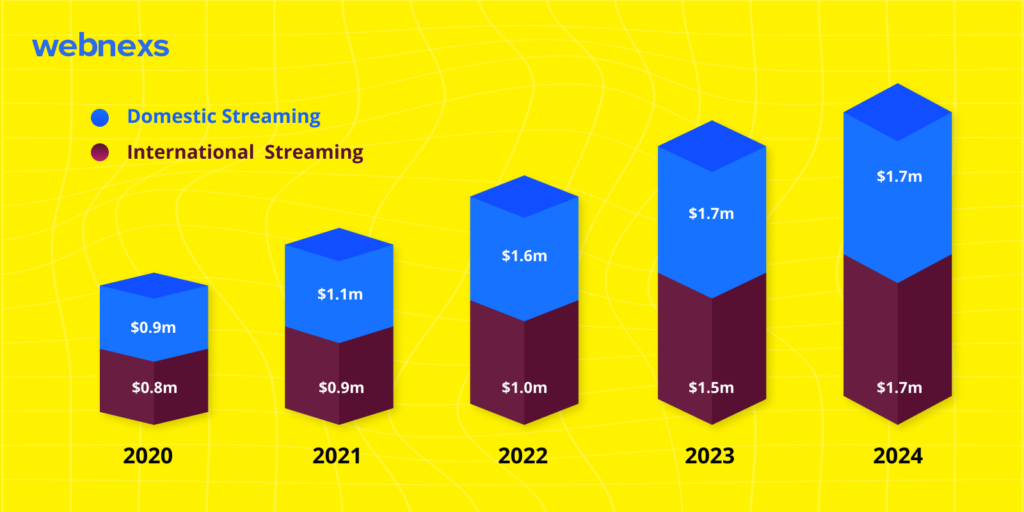The rise of streaming services has transformed the way people consume entertainment. Gone are the days of traditional cable subscriptions and DVD rentals—now, platforms like Netflix dominate the market by offering on-demand access to thousands of titles across various genres and languages. But how exactly does Netflix make money? Let’s explore its business model and revenue streams in detail.
The Evolution of Netflix
Netflix started as a DVD rental service in 1997, allowing customers to rent movies online and have them delivered to their homes. However, the company pivoted to streaming in 2007, revolutionizing the entertainment industry. Over the years, Netflix expanded globally, partnered with various device manufacturers, and began producing its own original content. By 2024, Netflix has also entered the live streaming market, further diversifying its offerings.
Netflix’s Growth Journey
Since its inception in 1997 as a DVD rental service, Netflix has undergone a phenomenal transformation into the world’s leading video streaming platform. Its remarkable expansion has been fueled by global reach, strategic innovation, and a commitment to high quality content.
Global Subscriber Growth
As of Q2 2024, Netflix boasts an impressive 277.65 million subscribers worldwide. The company’s streaming service, launched in 2007, began with a modest user base of 7.32 million. By 2011, Netflix had grown to 25 million global subscribers. In 2017, bolstered by aggressive international expansion and a strong portfolio of original content, the platform crossed the 100 million subscriber mark. By 2021, Netflix surpassed 200 million users, solidifying its dominance in the highly competitive OTT market.
Subscriber Growth by Region
- North America: Netflix continues to maintain a strong foothold in the US and Canada, with 84.11 million subscribers as of Q2 2024, contributing to 30.32% of its global user base.
- Asia-Pacific: Rapid expansion in Japan, South Korea, and India has fueled growth in the APAC region, where Netflix now has 45.34 million subscribers, accounting for 17.42% of its global share.
- Latin America: With 46 million paid members, Latin America remains a key market, with Brazil and Mexico leading in subscriber count.
- EMEA (Europe, Middle East, and Africa): The fastest-growing region for Netflix, EMEA now has 88.81 million subscribers, representing 34.12% of the platform’s global paying audience.
Netflix’s Revenue Growth
Netflix’s financial success is driven by a combination of increasing subscriber numbers, strategic pricing adjustments, and market expansion. In 2023, the company recorded an annual revenue of $33.72 billion, marking a 6.78% increase from the previous year’s $31.62 billion.
In 2017, Netflix generated $11.69 billion in revenue, which grew to $24.99 billion by 2020. As of 2023, the US and Canada remain Netflix’s top revenue-generating markets, followed by the EMEA region.
Netflix’s growth story is a testament to its ability to innovate, adapt, and scale in an ever-evolving digital entertainment landscape.
How Does Netflix Make Money? – Netflix Business Model Explained
Netflix Make Money With Subscriptions Plan

The backbone of Netflix’s revenue model is its subscription-based streaming service. Over 90% of its revenue comes from user subscriptions, which provide unlimited access to content without additional charges.
Netflix offers tiered pricing plans based on video quality and the number of concurrent screens:
- Mobile Plan: $8.99/month – Single mobile device access.
- Basic Plan: $9.99/month – One device access with HD streaming.
- Standard Plan: $18.99/month – Two devices with Full HD streaming.
- Premium Plan: $25.99/month – Four devices with 4K UHD streaming.
These subscription plans cater to different customer needs, from solo mobile users to families sharing an account.
Additional Revenue Streams
Netflix has expanded its revenue model beyond subscriptions by integrating various monetization strategies:
1. Advertising-Supported Plans
Netflix introduced an ad-supported subscription tier, allowing budget-conscious users to access the platform at a lower price while brands pay Netflix to display targeted ads. This move has unlocked a new revenue stream and expanded its customer base.
2. Licensing and Content Distribution
Netflix invests heavily in region-specific content, leading to massive success with shows like Sacred Games (India), Dark (Germany), and Squid Game (South Korea). This generates additional revenue while broadening the reach of its content.
3. Netflix Merchandise Sales
Netflix has launched an official online store featuring merchandise from popular shows like Stranger Things and Squid Game. Products include apparel, collectibles, and accessories, providing an additional revenue stream beyond digital content.
4. Strategic Partnerships
Netflix collaborates with telecom providers, internet service providers (ISPs), and device manufacturers to bundle its service with their offerings.
Netflix expands its reach by partnering with:
- Telecom providers (bundled subscriptions with mobile plans)
- Smart TV brands (pre-installed Netflix apps)
- Streaming platforms like Roku and Amazon Fire TV
5. Brand Collaborations & Product Placements
Many global brands collaborate with Netflix to feature their products in its original content. These subtle in-show promotions create brand awareness while adding to Netflix’s revenue.
6. Live Events & Ticket Sales
With the expansion into live streaming, Netflix now broadcasts exclusive events, including sports and concerts. It generates revenue through ticket sales, sponsorships, and pay-per-view access.
How Netflix Delivers Seamless Streaming

Netflix operates on a highly sophisticated tech stack to ensure smooth, high-quality streaming:
1. Cloud-Based Architecture & Content Delivery
Netflix runs on Amazon Web Services (AWS) and uses its custom Open Connect CDN to cache content closer to users, reducing buffering and improving streaming speeds.
2. AI-Powered Personalization
Netflix’s advanced AI & Machine Learning (ML) algorithms analyze user behavior to recommend content based on:
- Viewing history
- Genre preferences
- Engagement patterns
3. Advanced Video Streaming Tech
- Adaptive Bitrate Streaming (ABR): Adjusts quality based on internet speed
- AV1 Codec: Optimized compression for high-quality video at lower bandwidth
- Seamless UI/UX: Netflix works across smartphones, tablets, smart TVs, gaming consoles, and browsers
Build a Netflix-like video streaming platform with security and scalability.
How Much Does Netflix Cost To Run?

Netflix, a global leader in the streaming industry, generates massive revenue, but it also incurs significant operational expenses. The company continuously invests in content, technology, and user experience to stay ahead of the competition. Here’s a detailed look at Netflix’s cost structure and how it sustains profitability.
| Year | Content Spending (in Billion $) |
| 2013 | $ 2.38 Billion |
| 2014 | $ 3.18 Billion |
| 2015 | $ 4.61 Billion |
| 2016 | $ 6.88 Billion |
| 2017 | $ 8.91 Billion |
| 2018 | $ 12.04 Billion |
| 2019 | $ 14.61 Billion |
| 2020 | $ 17.3 Billion |
| 2021 | $ 17.7 Billion |
| 2022 | $ 16.7 Billion |
| 2023 | $ 13.0 Billion |
| 2024* | $ 17.0 Billion |
One of the largest expenses for Netflix is content investment. The company allocates a substantial portion of its budget to content production and acquisition. Over the past five years, it has spent an average of $17 billion annually on licensing and original productions to ensure a diverse and engaging library for its users.
Infrastructure and Technology. To deliver smooth and high-quality streaming, Netflix invests around $1 billion per year in cloud computing, data security, content delivery networks, and server maintenance. These investments help optimize video delivery across different devices and varying network conditions, ensuring a seamless viewing experience for users worldwide.
Marketing and User Acquisition: It become essential for Netflix. The company spends significantly on marketing strategies, partnerships, and advertising campaigns to attract new subscribers and retain existing users. This includes digital marketing, promotional offers, and collaborations with telecom providers and smart TV manufacturers.
Research and development : It is another priority for Netflix, as it continually seeks to improve user experience. As a pioneer in the streaming industry, the company invests heavily in AI and machine learning to enhance content recommendations, optimize streaming quality, and develop new features that keep users engaged.
Sustaining Profitability
Despite these high operational costs, Netflix remains highly profitable. In the last fiscal year, the company reported an impressive $5.4 billion in profit. This demonstrates its ability to balance expenses while driving consistent revenue growth through a combination of subscription fees, content innovation, and technological advancements.
Financial Performance & Market Growth
Netflix has demonstrated strong financial growth, with an annual revenue increase of 14% between 2019 and 2024. It has a market cap of $383.64 billion and ranks among the top U.S. companies. Despite occasional challenges, such as its crackdown on password sharing and market saturation in certain regions, Netflix continues to evolve and attract new subscribers.
The Future of Netflix’s Revenue Model
The company’s latest venture into live-streaming sports, such as WWE in 2025, indicates an effort to diversify content offerings and attract a new segment of subscribers. However, rising content production costs and increasing competition from other streaming services could impact its profitability in the long run.
Build Your Own Streaming Service with Webnexs

The success of Netflix proves that OTT platforms are highly profitable when executed with the right strategy. If you want to build your own streaming service, Webnexs provides cutting-edge solutions tailored to your needs.
Our platform offers:
- Multi-platform streaming (Web, Mobile, Smart TV)
- Multiple monetization models (SVOD, AVOD, TVOD)
- Seamless content delivery with integrated CDN
- 50+ third-party integrations
Take your streaming business to the next level with Webnexs. Get in touch with us today!



4 Responses
The way Netflix makes money from different markets by offering mobile-only plans at lower prices shows their ability to adapt to consumer needs.
With Netflix investing in gaming, it will be interesting to see if that becomes another way Netflix makes money in the future.
I had no idea Netflix makes money from licensing its own content to other platforms. That’s a smart way to generate extra revenue!
With Netflix investing in gaming, it will be interesting to see if that becomes another way Netflix makes money in the future.